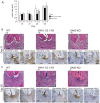Serum Amyloid A Contributes to Chronic Apical Periodontitis via TLR2 and TLR4
- PMID: 30189157
- PMCID: PMC6304714
- DOI: 10.1177/0022034518796456
Serum Amyloid A Contributes to Chronic Apical Periodontitis via TLR2 and TLR4
Abstract
In the current concept of bacterial infections, pathogen-associated molecular patterns (PAMPs) derived from pathogens and damage-associated molecular patterns (DAMPs) released from damaged/necrotic host cells are crucial factors in induction of innate immune responses. However, the implication of DAMPs in apical and marginal periodontitis is unknown. Serum amyloid A (SAA) is a DAMP that is involved in the development of various chronic inflammatory diseases, such as rheumatoid arthritis. In the present study, we tested whether SAA is involved in the pathogenesis of periapical lesions, using human periapical surgical specimens and mice deficient in SAA and Toll-like receptors (TLR). SAA1/2 was locally expressed in human periapical lesions at the mRNA and protein levels. The level of SAA protein appeared to be positively associated with the inflammatory status of the lesions. In the development of mouse periapical inflammation, SAA1.1/2.1 was elevated locally and systemically in wild-type (WT) mice. Although SAA1.1/2.1 double-knockout and SAA3 knockout mice had redundant attenuation of the extent of periapical lesions, these animals showed strikingly improved inflammatory cell infiltration versus WT. Recombinant human SAA1 (rhSAA1) directly induced chemotaxis of WT neutrophils in a dose-dependent manner in vitro. In addition, rhSAA1 stimulation significantly prolonged the survival of WT neutrophils as compared with nonstimulated neutrophils. Furthermore, rhSAA1 activated the NF-κB pathway and subsequent IL-1α production in macrophages in a dose-dependent manner. However, TLR2/TLR4 double deficiency substantially diminished these SAA-mediated proinflammatory responses. Taken together, the SAA-TLR axis plays an important role in the chronicity of periapical inflammation via induction of inflammatory cell infiltration and prolonged cell survival. The interactions of PAMPs and DAMPs require further investigation in dental/oral inflammation.
Keywords: alarmins; chemotaxis; endodontics; inflammation; innate immunity; pattern recognition receptors.
Conflict of interest statement
The authors declare no potential conflicts of interest with respect to the authorship and/or publication of this article.
Figures





References
-
- Bianchi ME. 2007. DAMPs, PAMPs and alarmins: all we need to know about danger. J Leukoc Biol. 81(1):1–5. - PubMed
-
- Bozinovski S, Uddin M, Vlahos R, Thompson M, McQualter JL, Merritt A-S, Wark P, Hutchinson A, Irving L, Levy B, et al. 2012. Serum amyloid A opposes lipoxin A4 to mediate glucocorticoid refractory lung inflammation in chronic obstructive pulmonary disease. Proc Natl Acad Sci U S A. 109(3):935–940. - PMC - PubMed
Publication types
MeSH terms
Substances
Grants and funding
LinkOut - more resources
Full Text Sources
Other Literature Sources
Miscellaneous

